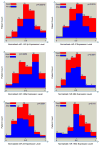A microRNA expression signature for the prognosis of oropharyngeal squamous cell carcinoma
- PMID: 22736309
- PMCID: PMC3461127
- DOI: 10.1002/cncr.27696
A microRNA expression signature for the prognosis of oropharyngeal squamous cell carcinoma
Abstract
Background: Oropharyngeal squamous cell carcinoma (SCC) rates have been increasing significantly in recent years, despite a decreasing incidence of head and neck cancer in general. Oropharyngeal SCC has many characteristics that are distinct from other head and neck cancers, and thus it is important to focus specifically on cancers arising in this region, with the goal of improving patient outcomes. One important goal is to identify those patients who are likely to fail standard therapy and who could potentially benefit from alternative or targeted treatments.
Methods: In the current study, the prognostic value of microRNAs (miRNAs) was evaluated in patients with oropharyngeal SCC. miRNAs are small, noncoding RNAs that are master regulators of many important biological processes. In total, 150 oropharyngeal tumors were analyzed using the recently developed quantitative polymerase chain reaction-based method for miRNA expression profiling. In addition, the expression of miRNAs was also compared with human papillomavirus (HPV) transcriptional activities.
Results: The current study identified 6 miRNAs that were found to be significantly associated with cancer survival. A combined expression signature of these miRNAs was prognostic of oropharyngeal SCC, independent of common clinical features or HPV status.
Conclusions: This new miRNA signature was experimentally validated in an independent oropharyngeal SCC cohort. Furthermore, 5 HPV-related miRNAs were identified, which may help to characterize HPV-induced cancers including both oropharyngeal and cervical SCC.
Copyright © 2012 American Cancer Society.
Figures




Similar articles
-
Genome-wide miRNA profiling reinforces the importance of miR-9 in human papillomavirus associated oral and oropharyngeal head and neck cancer.Sci Rep. 2019 Feb 19;9(1):2306. doi: 10.1038/s41598-019-38797-z. Sci Rep. 2019. PMID: 30783190 Free PMC article.
-
DNA-PkCS expression in oropharyngeal squamous cell carcinoma: Correlations with human papillomavirus status and recurrence after transoral robotic surgery.Head Neck. 2017 Feb;39(2):206-214. doi: 10.1002/hed.24562. Epub 2016 Aug 10. Head Neck. 2017. PMID: 27507640
-
A novel RT-PCR method for quantification of human papillomavirus transcripts in archived tissues and its application in oropharyngeal cancer prognosis.Int J Cancer. 2013 Feb 15;132(4):882-90. doi: 10.1002/ijc.27739. Epub 2012 Sep 7. Int J Cancer. 2013. PMID: 22821242 Free PMC article.
-
An Update on Cellular MicroRNA Expression in Human Papillomavirus-Associated Head and Neck Squamous Cell Carcinoma.Oncology. 2018;95(4):193-201. doi: 10.1159/000489786. Epub 2018 Jun 19. Oncology. 2018. PMID: 29920485 Review.
-
The Genomics, Epigenomics, and Transcriptomics of HPV-Associated Oropharyngeal Cancer--Understanding the Basis of a Rapidly Evolving Disease.Adv Genet. 2016;93:1-56. doi: 10.1016/bs.adgen.2015.12.001. Epub 2016 Feb 9. Adv Genet. 2016. PMID: 26915269 Review.
Cited by
-
MicroRNA-18a regulates the metastatic properties of oral squamous cell carcinoma cells via HIF-1α expression.BMC Oral Health. 2022 Sep 5;22(1):378. doi: 10.1186/s12903-022-02425-6. BMC Oral Health. 2022. PMID: 36064348 Free PMC article.
-
Prognostic Markers and Driver Genes and Options for Targeted Therapy in Human-Papillomavirus-Positive Tonsillar and Base-of-Tongue Squamous Cell Carcinoma.Viruses. 2021 May 14;13(5):910. doi: 10.3390/v13050910. Viruses. 2021. PMID: 34069114 Free PMC article. Review.
-
MicroRNAs: potential biomarkers for diagnosis and prognosis of different cancers.Transl Cancer Res. 2020 Sep;9(9):5798-5818. doi: 10.21037/tcr-20-1294. Transl Cancer Res. 2020. PMID: 35117940 Free PMC article. Review.
-
MicroRNAs: Their Role in Metabolism, Tumor Microenvironment, and Therapeutic Implications in Head and Neck Squamous Cell Carcinoma.Cancers (Basel). 2021 Nov 9;13(22):5604. doi: 10.3390/cancers13225604. Cancers (Basel). 2021. PMID: 34830755 Free PMC article. Review.
-
Neuroendocrine Key Regulator Gene Expression in Merkel Cell Carcinoma.Neoplasia. 2018 Dec;20(12):1227-1235. doi: 10.1016/j.neo.2018.10.003. Epub 2018 Nov 7. Neoplasia. 2018. PMID: 30414538 Free PMC article.
References
-
- D’Souza G, Kreimer AR, Viscidi R, et al. Case-control study of human papillomavirus and oropharyngeal cancer. N Engl J Med. 2007;356:1944–1956. - PubMed
-
- Gillison ML, D’Souza G, Westra W, et al. Distinct risk factor profiles for human papillomavirus type 16-positive and human papillomavirus type 16-negative head and neck cancers. J Natl Cancer Inst. 2008;100:407–420. - PubMed
-
- Fakhry C, Westra WH, Li S, et al. Improved survival of patients with human papillomavirus-positive head and neck squamous cell carcinoma in a prospective clinical trial. J Natl Cancer Inst. 2008;100:261–269. - PubMed
Publication types
MeSH terms
Substances
Grants and funding
LinkOut - more resources
Full Text Sources
Other Literature Sources
Research Materials

